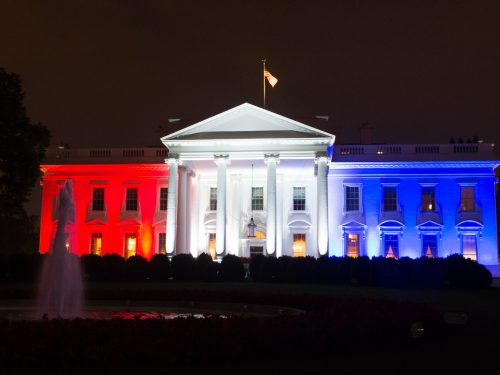
A surefire way to get your kids and teens excited about American history is to plan a family or class visit to the White House.
The White House often approves tours specifically for children. Here are some suggestions to make the visit pleasurable and interesting.
Plan Ahead
In our post-9/11 increased-security world, visiting the White House cannot be a spontaneous decision. Any member of the general public can tour the White House, but you must prepare in advance and make a formal request to visit the house. Public tours are available from 7:30 a.m. to 11:30 a.m. Tuesday through Thursday and from 7:30 a.m. to 1:30 p.m. on Friday and Saturday (excluding federal holidays or unless otherwise noted). Tour hours will be extended when possible based on the official White House schedule. Tours are scheduled for groups of ten or more people. Here are the steps you need to take to ensure a successful White House visit.
Set a Date for Your Visit
If you want to make a tour of the White House a part of your vacation or visit to Washington, D.C., you must choose the date of your visit and get your request in at least a month before that date. Requests are accepted up to six months in advance. You are encouraged to submit your request as early as possible because a limited number of tours is available.
Requests must be submitted through your Congressional representative—your local Congress person or one of the senators from your home state. Some representatives have online request forms; others do not. You must contact your Congressional representatives to find out what their particular office requires before you send in your request.
To locate your senators and their contact information, visit the Senate.gov website.
To find your Congressional representative and his or her contact information, you must first look up your four-digit zip code extension, which you can do using the zip4.usps.com website. Then, using that zip code information, go to the House of Representatives website.
Or, once you know who your representative and senators are, visit their individual websites to obtain their contact information.
There are no fees or admission charges to visit the White House or the White House Visitor Center. Visits are scheduled on a first-come, first-served basis. All visitors should call the 24-hour Visitor Center information line at 202-456-7041 to determine if any last-minute changes have been made in the tour schedule as events can alter White House accessibility.

Information You Need for Your Visitor Request
Everyone who visits the White House must have clearance from the United States Secret Service.
If your party alone does not make a group of ten, request to be matched up with another small party of visitors. The person requesting the visit should specify in the request all personal contact information including address, phone number, and fax and email address if pertinent. You should be notified approximately one month before the requested date.
In your visitor request you must list the name and date of birth for any person who is under the age of eighteen by the date of your visit. For those in your party who are over eighteen years of age, you must list their names, dates of birth, social security numbers, and countries of citizenship. The National Park Service states that this security information must be received by the office through which tickets are obtained no later than five business days prior to the tour date. Groups without security information will be cancelled.
Note in your request if any of your party is hearing, visually, or mobility impaired. Tours for hearing-impaired groups of ten or more may be requested through one’s member of Congress. The Visitor Center TDD (telephone device for the deaf) is 202-456-2121. Tours for visually-impaired groups of ten or more may be requested through one’s member of Congress. Guide animals are permitted in the White House.
Know that for a wide variety of reasons, White House tours can be cancelled at any time. For the most current tour information, please call the 24-hour line at 202-456-7041.

The Day of Your White House Visit
Plan to get to the Presidential Park at least fifteen minutes beforehand if you are touring the building. You and your family will enter the White House by the south side of East Executive Avenue near the Southeast Gate. National Park Service rangers and volunteers are posted at the corner of 15th and E Streets to assist you. For directions to the White House, parking information, travel information—and everything else related to a White House visit—go to the National Park Service website.
We suggest that you arrive about an hour before you visit so that you and your family or students can stop at the White House Visitor Center to see the exhibits and watch a video of the White House. You can also go there after your visit. The White House Visitor Center, located at 1450 Pennsylvania Ave. NW, is open from 7:30 a.m. until 4:00 p.m. daily (except January 1, Thanksgiving, and December 25). Admission is free.
“At the White House Visitor Center, you can explore an interactive touchscreen tour of the White House, view over 90 artifacts from the White House collection, shop at the White House Historical Association retail store, and view the 14-minute film, ‘White House: Reflections From Within.’ Visit the information desk to inquire about special ranger programs and events at President’s Park.” There are also public restrooms at the center. For information about the White House Visitor Center, go to WhiteHouseHistory.org.
All guests 18 years of age or older will be required to present a valid, government-issued photo identification (detailed below). All foreign nationals must present their passport. All other forms of foreign identification will not be accepted. All information submitted (e.g. name, date of birth, city, etc.) must exactly match the government-issued photo ID you will present when arriving at the White House.
The following forms of photo ID are acceptable for presentation to U.S. Secret Service upon entry to the White House complex:
• Valid government-issued United States identification card (e.g. drivers license, military ID, etc.)
• Valid United States or other official government-issued passports
No other forms of identification will be accepted; photocopies, expired IDs, or other transmissions of these documents are NOT valid. Individuals whose identification does not exactly match the name or date cleared will be denied entry to the White House.
You cannot take the following items on the White House tour: video recorders; handbags, book bags, backpacks, or purses; food or beverages; tobacco products; personal grooming items (i.e. makeup, lotion, etc.); strollers; any pointed objects; aerosol containers; guns, ammunition, fireworks, electric stun guns, mace, martial arts weapons/devices, or knives of any size.
The U.S. Secret Service reserves the right to prohibit any other personal items. Umbrellas, wallets, car keys, and cell phones (including those with cameras) are permitted. However, guests will not be allowed to use cell phones inside the White House. Phones used inside the White House may be confiscated by U.S. Secret Service.
Please note that video cameras, including any action camcorders, cameras with detachable lenses, tablets, tripods, monopods, and camera sticks are not permitted. Flash photography, live streaming, and talking or texting on cellular phones are not permitted while on the tour.
As of July 1, 2015, smartphones and compact cameras with a lens no longer than 3 inches (stills only) are permitted on the public tour route as long as their use does not interfere with other guests’ enjoyment of the tour.
Please note that no storage facilities are available on or around the complex. Individuals who arrive with prohibited items will not be permitted to enter the White House.
Scheduled visitors who require the loan of a wheelchair should notify the officer at the Visitors Entrance upon arrival. Unfortunately, wheelchair reservations are not possible. Visitors in wheelchairs, or with other mobility disabilities, use the same Visitors Entrance and are escorted by ramp from the entrance level to the Ground floor, and by the elevator from the Ground floor to the State floor.
Parking: The closest Metrorail stations to the White House are Federal Triangle (blue and orange lines), Metro Center (blue, orange, and red lines) and McPherson Square (blue and orange lines). On-street parking is not available near the White House, and use of public transportation is strongly encouraged.
Restrooms: The nearest restrooms to the White House are in the Ellipse Visitor Pavilion (the park area south of the White House). Restrooms and public telephones are not available at the White House.
Preparing the Young People in Your Life for a Visit to the White House
Read and share the Our White House: Looking In, Looking Out book and website with your kids and teens before you visit our White House. And be sure to look through and share other books and websites about the White House, the presidents, the first ladies, their families, pets, and staff before you visit Washington. You will find many great book and website suggestions in our bibliography “Presidents, the President’s House, and More: A Select List of Books for Young People.”
After sharing a book or two with young people, ask them what they think the White House is—is it a home; a museum; a place of work? You might also look at pictures in books that show the exterior of the house and the public rooms—and pick out details of interest that your children and students can find on their tour. For fun, make up a White House scavenger hunt checklist of items that interest you and the young person, including furniture details, presidential portraits, paintings, architectural details, etc., and after your visit see how many of those details you saw on your tour.
Before you go you and your kids can take a virtual tour of the White House on the White House website WhiteHouse.gov.
Whatever the age of your children or students, take a moment and talk to them about your expectations for the visit. Talk to them about appropriate behavior and conversation at the White House. Sometimes it helps to compare and contrast behaviors for various kinds of situations. For example, you might say that it is appropriate to yell and shout at a baseball or basketball game, but in someone’s home, like the president’s home, that is not acceptable behavior. Let them know it is all right to ask questions during the tour. And let them know that they need to follow rules and directions.
If you plan your trip in advance and prepare your family or students for the visit, you will all have a great time at our White House!
Resources
Websites that will help you plan your trip:
- Tours and event information on the White House website: WhiteHouse.gov/participate/tours-and-events
- White House tour information on the National Park Service website: nps.gov/whho/planyourvisit/the-white-house-tour.htm
Additional White House educational information and materials are available on the White House History website: WhiteHouseHistory.org/teacher-resources
This article is ©2016 Mary Brigid Barrett; The National Children’s Book and Literacy Alliance and first published here.
Note: Pediatrician Tips is strictly a news and information website about pediatrics. It does not provide medical advice, diagnosis, or treatment. This content is not intended to be a substitute for professional medical advice, diagnosis, or treatment. Always seek the advice of your pediatrician, physician or another qualified health provider with any questions you may have regarding a medical condition for any person. Never disregard professional medical advice or delay in seeking it because of something you have read on this website. The opinions expressed in this column are not always those of Pediatrician Tips and are intended to spark discussion about issues pertaining to pediatrics and pediatricians.








